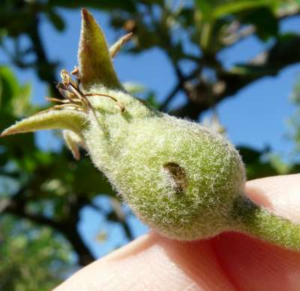Orchards in the highest elevation and coolest areas are at or just past petal fall, so all the advice I’ve had for other growers applies there as well now. All orchards should have started or, more likely, completed chemical thinning by now. Fabulous thinning weather occurred last week and those who applied the usual materials should see the effects by now. If a little more ‘nudge’ is needed to break up clusters, carbaryl , 6-BA 9 (Maxcel, etc.), and NAA (Refine, etc.) will still work so long as the fruit you’re thinning are under 15 mm diameter. If you have a lot of larger fruit, up to 20 mm, then Ethephon + carbaryl can help in a pinch, but be careful, as that mixture is relatively unpredictable. Wes Autio and Win Cowgill have a factsheet on such rescue thinning for more information.
Regular readers may have noted that I (almost) took a week off from updates- I also took a week off from spraying. Where petal fall insecticides were applied against plum curculio (PC) and European apple sawfly, you’re probably good until another is needed for PC due to rain washoff or codling moth rears its head. As for the former, PC is only ‘programmed’ to lay eggs and cause fruit damage for about 308 degree days (base 50) after McIntosh petal fall, and we’re only about 1/3 there at the UVM Hort Farm. It would be wise to check for PC damage to fruitlets and consider reapplication at the first sign of fresh damage.
Figure 1Plum curculio damage on a developing fruitlet. This damage is about a week old, note the dried surface and lack of sap. Fresh stings after an insecticide has been applied indicate potential need to reapply.
As for the latter pest, codling moth have now been trapped in most scouted orchards in the state. To best manage the first generation of this pest, calculate degree days (base 50°F) from the date of first capture in pheromone traps. Most materials should be applied at 200 degree days after catch, which should be in the next week or so. Cornell entomologist Dr. Art Agnello offers the following specific recommendations for CM management in the latest Scaffolds newsletter: “The best products for controlling both CM and OFM in apples and stone fruits are those in IRAC Group 28 (containing a diamide; i.e., Altacor, Exirel, Minecto Pro, Voliam Flexi or Besiege) or IRAC Group 5 (mainly spinetoram, Delegate; spinosad, formulated as Entrust, is an organically approved option). Two applications from either of these groups on a 10–14-day interval would be recommended starting at 220 DD50 from biofix; we’re already beyond this point in Highland and Geneva, but sites in WNY range from 81-247 DD50, depending on proximity to the lake (refer to “Model Building” numbers in this issue). Products with insect growth regulator activity, such as Rimon, Intrepid or Esteem, would also be suitable options this week in apple sites at the lower end of these values. Other products with activity against internal leps include the neonic Assail, the biological Grandevo (also organically approved) and, in orchards where resistance has not developed to the newer pyrethroids, also Baythroid, Danitol, Endigo, and Leverage. Most older broad-spectrum materials like Imidan, Lannate, and the older pyrethroids, which were formerly more effective, are generally not as good choices because of insecticide resistance issues…Now would also be an appropriate time for an application of a granulosis virus product in pome and stone fruits such as Cyd-X, Madex, Virosoft CP4 or Carpovirusine (apples and pears only), in addition to the larvicides discussed above. These are biological insecticides, which must be ingested to initiate the infection, after which the virus replicates inside the larva until it is killed; this releases more virus particles into the orchard. This is a very useful approach for long-term population reduction, particularly when used in at least 2 applications per generation. Madex, and now Virosoft CP4 (see “Chem News” in this issue) contain an isolate that is also effective against OFM.”
As for diseases, all sites should be done with primary apple scab season. That doesn’t mean that scab management is done, just that there are no overwintering spores left in leaf litter. If you have NO scab, you’re done managing this disease for the year. However, I suspect that many orchards missed an infection period or had spotty coverage, and that there is a good bit of scab out there. If you have scab, plan on maintaining some level of preventative fungicide (Captan is about all you have, sulfur if organic) for the next month or so until fruit and foliage become resistant. Do not use single-site fungicides like DMIs, strobilurins, or SDHIs (FRAC codes 3,7, 9,11) on active lesions to reduce development of fungicide resistance.
There have been some reports of fire blight showing up from the marginal infection periods that occurred May 20, 23, or 26. Keep your eyes out, especially in blocks that have had a history of the disease or on susceptible cultivars like Gala and Paulared, and cut strikes out as you see them.
If using nitrogen fertilizers in your orchard, plan on wrapping up applications in the next week or two to give trees time to harden off for winter. Potassium fertilizers can go on any time now.
Where trade names or commercial products are used for identification,
no discrimination is intended and no endorsement is implied.
Always read the label before using any pesticide.
The label is the legal document for the product use.
Disregard any information in this message if it is in conflict with the
label.
The UVM Tree Fruit and Viticulture Program is supported by the
University of Vermont Agriculture Experiment Station, a USDA NIFA E-IPM
Grant, and USDA Risk Management Agency Funds.

